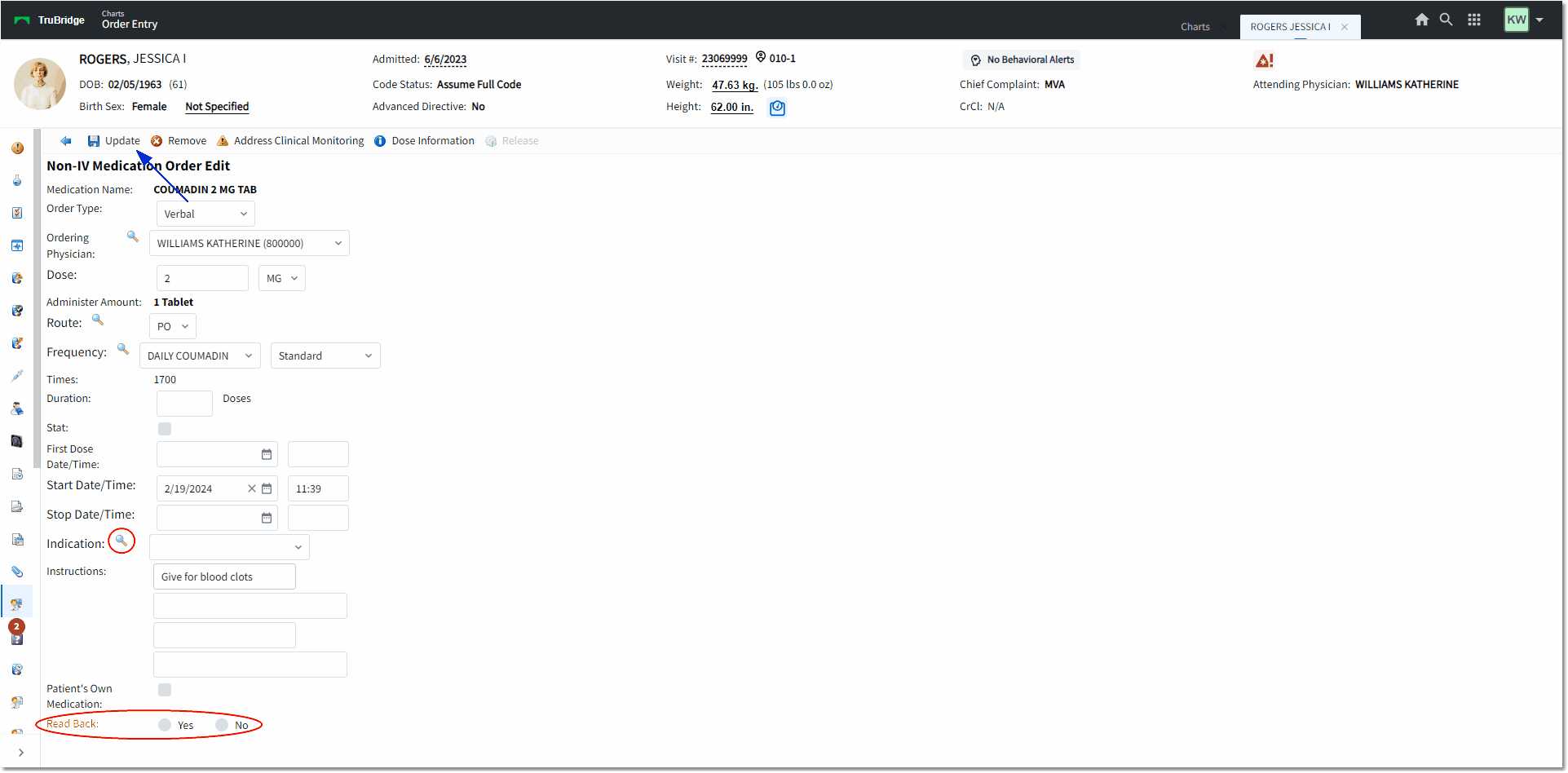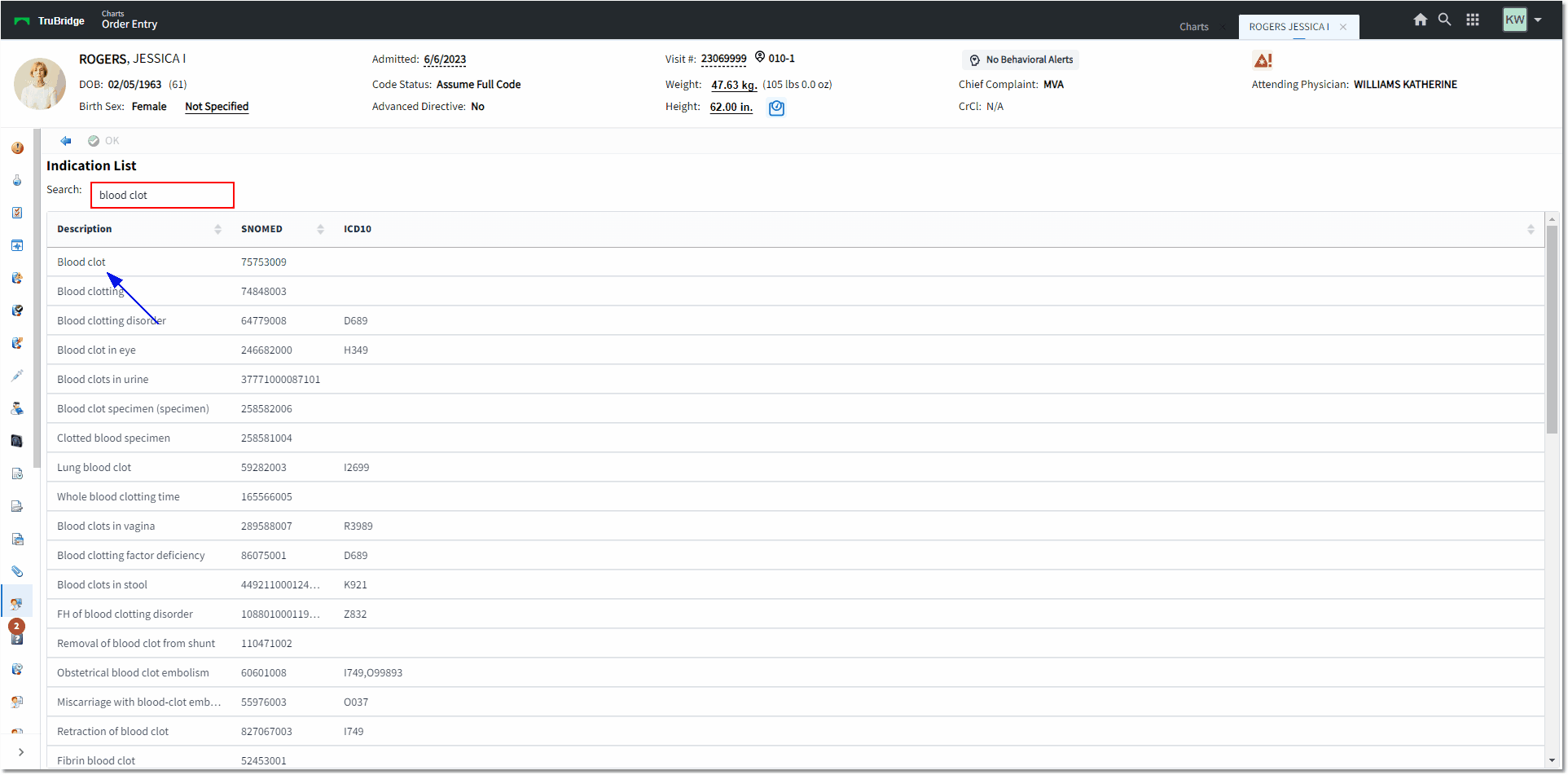|
<< Click to Display Table of Contents >> Non-IV Medication Order Review |
  
|
|
<< Click to Display Table of Contents >> Non-IV Medication Order Review |
  
|
Medication Order Edit screens will vary depending on whether the item is IV or Non-IV.
Select the Non-IV item that requires editing by double-clicking the item name from Pending Orders or by selecting the item and then Edit. Required fields that are unaddressed will appear in red.
Select Order Entry > Select Pending Item > Edit

Non-IV Medication Order Edit
The fields on the Non-IV Order screen will appear in the following order, and any fields that require editing will appear in red.
•Medication Name: The Medication Name will be listed in bold, and functions as a hyperlink. When the name is selected, the Drug Monograph Information will open. Information such as the NDC Number, Drug Notes, Package-Product Information, UltiMedex/Company Information, Ingredients, Class Information, and Patient Specific Dosing will be available from this option.
•Order Type: The Order Type that was selected on the Search Order screen will display but may be changed by selecting the drop-down menu and selecting the Order Type from the list. This option is specific to nursing.
•Ordering Physician: The Physician that was entered on the Search Orders screen will populate this field but may be changed to allow users to place orders from multiple physicians at one time. This option is specific to nursing.
▪Select the magnifying glass icon to display the Physician Look-Up screen.
▪Staff physicians are listed in alphabetical order with the physician number to the right of the name. The search option may be changed to list the physicians by their physician number. If the physician is not located in the Staff Index, or the physician is not on staff, select Non-Staff. To change the ordering physician, double click the physician's name from the look up table.
•Dose: If the item has a predefined dose and unit, it will automatically populate these fields.
▪To change the dose, select the Dose field and type in the correct value.
▪To change the unit, select the correct unit from the Unit drop-down menu.
•Route: If the item has a predefined Route, it will automatically populate this field.
▪To change the route, select the magnifying glass icon. (NOTE: If the Pharmacy Control table switch "Only Allow Predefined Routes in OE" has been checked, the Route look-up will not be available and the user must choose from the pre-defined frequencies for the selected medication.)
▪The available routes will be listed in alphabetical order by Route Name. To sort the routes by Type or Description, select the Route drop-down menu and select the desired item.
▪To search for a specific route, type the beginning description of the route into the Search field; the list will automatically populate.
▪Once the desired route has been located and selected, select the Select icon from the action bar or double-click to insert the route.
•Frequency: If the item has a predefined frequency, it will automatically populate this field. To select a different Non-IV frequency, select the magnifying glass icon. (See PRN Reason below for any items set with a PRN frequency.)
•Time: The standard times of a frequency will automatically populate to this field when a frequency is ordered with Standard Times. To change the scheduled times, select Non-Standard from the drop-down option. The Non-Standard option will be disabled if a X1 or PRN frequency have been selected in the frequency field. It will also be disabled if the frequency field is left blank.
•Duration: A max number of doses may be entered in the Duration field. The order will be automatically discontinued once the duration value has been met.
•Stat: Select the check box to make this medication order a stat order. When this option is selected, two orders will be automatically placed. The first order will have an X1 frequency and the second order will have the frequency that is entered in the Frequency field. To create only an X1 stat order without creating a routine order, select X1 as the frequency.
•First Dose Date/Time: Indicates when the first dose will be given to the patient. If the "Require First Dose Entry" switch is checked in the Pharmacy Control Table, the field should auto-populate with the current time as the Start Date/Time. If it is cleared and no time is entered, it will repopulate to the Start Date/Time field as it is required and cannot be left blank. To change this information, select the field. The Calendar look-up may be used to change the date.
▪The system uses both the date/time entered via the Set Start/Schedule Date button as well as Discontinue Days set up to calculate the correct First Dose date/time, Start date/time, and Stop date/time. This should apply only if the order is added to pending after the user changes the date/time via Set Start/Schedule date.
▪The system uses both the date/time entered via the Set Start/Schedule Date button as well as X1 functionality to apply the correct First Dose date/time, Start date/time, and Stop date/time. This should apply only if the order is added to pending after the user changes the date/time via Set Start/Schedule date.
▪The system uses both the date/time entered via the Set Start/Schedule Date button as well as the frequency set up on the item within the Order Set/Order List/Protocol to calculate the correct First Dose date/time, Start date/time, and Stop date/time. This should apply only if the order is added to pending after the user changes the date/time via Set Start/Schedule date.
▪The system uses both the date/time entered via the Set Start/Schedule Date button as well as the Days from Now set up in Order Set/List/Protocol maintenance to determine the Nursing order start date/time. This should apply only if the order is added to pending after the user changes the date/time via Set Start/Schedule date.
▪The system uses both the date/time entered via the Set Start/Schedule Date button as well as Start in Days from Now set up to calculate the correct First Dose date/time, Start date/time, and Stop date/time. This should apply only if the order is added to pending after the user changes the date/time via Set Start/Schedule date. **NOTE: If the item is set up with Discontinue Days, this will need to be incorporated as well to determine Start date/time information.
•Start Date/Time: The Start Date and Time will default to the current time. To change this information, select the field that needs to be addressed. The Calendar look up may be used to change the date.
NOTE: If an order is placed with a First Dose Date/Time that is prior to the Start Date/Time of the order and the selected frequency results in a dose that would be in between the First Dose Date/Time and the Start Date/Time, there is potential for a dose to be missed. If this occurs and Update is selected from the Medication Edit screen, the following warning message will appear. Selecting Yes will proceed with scheduling the medication as the user has ordered it. Selecting No will return the user to the Medication Edit screen so that the setup may be adjusted.

Warning Message
•Stop Date/Time: The Stop Date and Time may be entered in these fields. The order will be automatically discontinued when the Stop Date and Time is reached. If the order has a X1 frequency, the stop date and time will default to the current time.
•Indication: The Indication of Use or reason a patient is being administered a medication. This field will default to blank. If it is red, it will be required to address prior to Updating the item. Up to 20 pre-defined reasons may be listed in the drop-down, based on the category information associated with the medication's classification.
oThe field will display a magnifying glass lookup option to allow the users to launch the indications/reason table. If an indication is selected from the table, the field will read "OTHER - (selected indication).
oThe Indication List will use the current HLI lookup for SNOMED/ICD-10 and pull the user-defined description and association ICD-10 code.
oTo make the field required, the item itself will need to have "Indication Required" checked on pg 2 of Pharmacy Information.
NOTE: This is needed for Antimicrobial Stewardship, but may be setup for any medication.
•PRN Reason: This field will be present for orders set with a PRN frequency instead of the Indication field. PRN orders for medication must include the clinical indication for use unless there is only one clinical indication for use.
NOTE: If an Indication or PRN Reason is attached to a medication selected from an Order Set, Order List, or Protocol, the orders will populate with the pre-defined Indication or PRN Reason when placed into Pending Orders.
•Instructions: Up to four lines of instructions may be entered in the Instructions field. If an item has a predefined Instructions, the Instructions will automatically populate.
•Patient's Own Medication: If the medication that is being ordered is from the patient’s personal supply, select the box next to Patient’s Own Medication.
•Read Back: If an order is being placed as a Verbal or Phone order, Read Back will be listed in red. This field must be answered before the order may be saved. This option is specific to nursing staff placing a Verbal or Phone order.
To Add an Indication to the Order:
Select Order Entry > Select Pending Item > Edit > Indication lookup

Indication List
Once all of the Item fields have been addressed, the user has several available options from the action bar:
•Back Arrow: When selected, the Back Arrow will prompt for save confirmation if any changes have been made to the order.
▪If Yes is selected, the order will be exited without saving changes.
▪If No is selected, it will return the user to the Order Review screen.
•Update: Will save any order edit changes and will return the user to the previous screen
•Remove: Allows the user to individually address Clinical Monitoring on the item, if present.
•Address Clinical Monitoring: If the medication that is being ordered has generated any Clinical Monitoring alerts, the Address Clinical Monitoring icon will be displayed on the action bar. The results must be viewed unless the behavior controls to bypass certain checks have been turned on for the user. The Allergy Checking and Drug Interaction Checking may not be bypassed and must be viewed prior to Updating the orders.
▪To address Clinical Monitoring, select the action bar option. When selected, a screen will open showing all Clinical Monitoring results where required Clinical Monitoring overrides must be addressed.
•Dose Information: Patient specific dosing may be viewed by selecting Dose Information from the action bar.